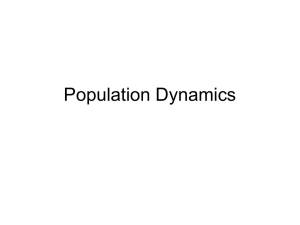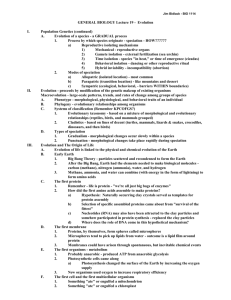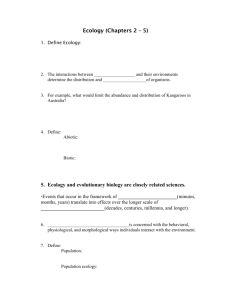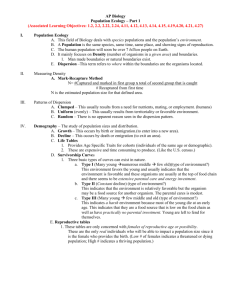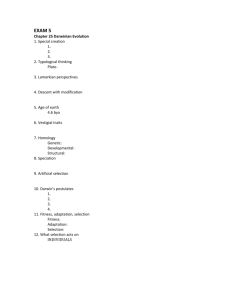Chapter 18 Outcomes - Fairmont State College
advertisement
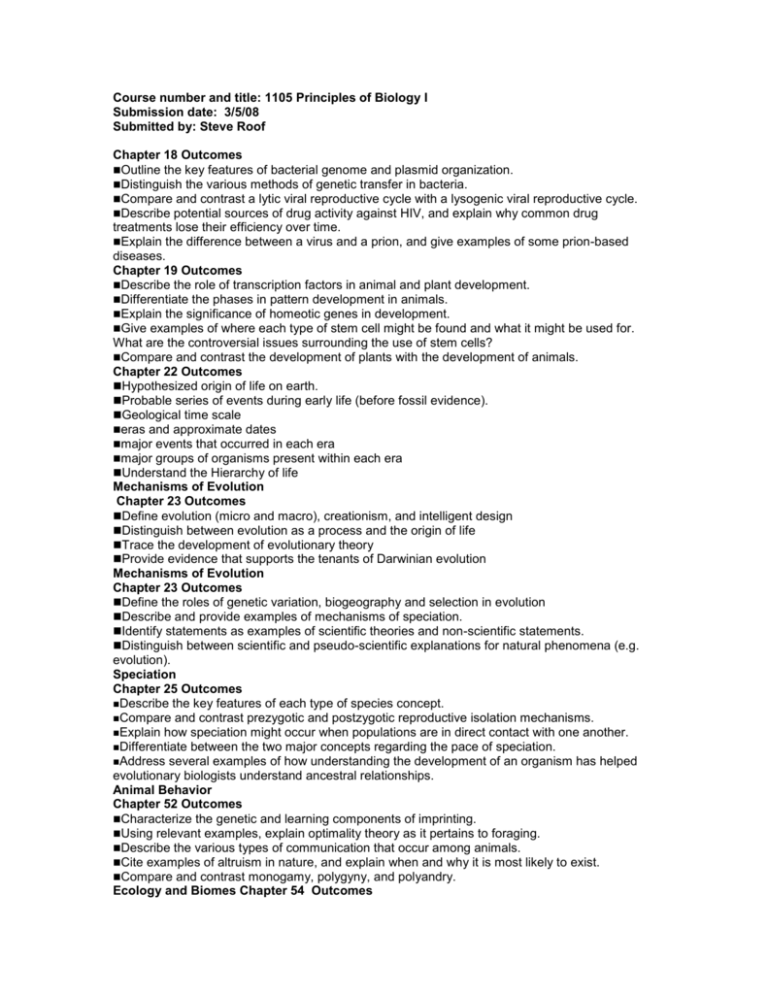
Course number and title: 1105 Principles of Biology I Submission date: 3/5/08 Submitted by: Steve Roof Chapter 18 Outcomes Outline the key features of bacterial genome and plasmid organization. Distinguish the various methods of genetic transfer in bacteria. Compare and contrast a lytic viral reproductive cycle with a lysogenic viral reproductive cycle. Describe potential sources of drug activity against HIV, and explain why common drug treatments lose their efficiency over time. Explain the difference between a virus and a prion, and give examples of some prion-based diseases. Chapter 19 Outcomes Describe the role of transcription factors in animal and plant development. Differentiate the phases in pattern development in animals. Explain the significance of homeotic genes in development. Give examples of where each type of stem cell might be found and what it might be used for. What are the controversial issues surrounding the use of stem cells? Compare and contrast the development of plants with the development of animals. Chapter 22 Outcomes Hypothesized origin of life on earth. Probable series of events during early life (before fossil evidence). Geological time scale eras and approximate dates major events that occurred in each era major groups of organisms present within each era Understand the Hierarchy of life Mechanisms of Evolution Chapter 23 Outcomes Define evolution (micro and macro), creationism, and intelligent design Distinguish between evolution as a process and the origin of life Trace the development of evolutionary theory Provide evidence that supports the tenants of Darwinian evolution Mechanisms of Evolution Chapter 23 Outcomes Define the roles of genetic variation, biogeography and selection in evolution Describe and provide examples of mechanisms of speciation. Identify statements as examples of scientific theories and non-scientific statements. Distinguish between scientific and pseudo-scientific explanations for natural phenomena (e.g. evolution). Speciation Chapter 25 Outcomes Describe the key features of each type of species concept. Compare and contrast prezygotic and postzygotic reproductive isolation mechanisms. Explain how speciation might occur when populations are in direct contact with one another. Differentiate between the two major concepts regarding the pace of speciation. Address several examples of how understanding the development of an organism has helped evolutionary biologists understand ancestral relationships. Animal Behavior Chapter 52 Outcomes Characterize the genetic and learning components of imprinting. Using relevant examples, explain optimality theory as it pertains to foraging. Describe the various types of communication that occur among animals. Cite examples of altruism in nature, and explain when and why it is most likely to exist. Compare and contrast monogamy, polygyny, and polyandry. Ecology and Biomes Chapter 54 Outcomes Provide examples of each of the scales of ecological study, including a typical experimental question that might be asked at each level. Characterize the effect of greenhouse gases on global temperature, and describe how their increasing levels is predicted to affect natural ecosystems. Explain how circulation patterns in the atmosphere affect climate and biome positioning. Describe how climate patterns define terrestrial biomes, and provide a representative example Biome types. Discuss energy flow through ecosystems and Trophic pyramids. Compare and contrast the types of aquatic biomes, including the typical array of species encountered. Animal Behavior Chapter 55 Outcomes Characterize the genetic and learning components of imprinting. Using relevant examples, explain optimality theory as it pertains to foraging. Describe the various types of communication that occur among animals. Cite examples of altruism in nature, and explain when and why it is most likely to exist. Compare and contrast monogamy, polygyny, and polyandry. Population Ecology Chapter 56 Outcomes Give examples of organisms with different survivorship curves, r/K selection, and population growth charts. Interpret survivorship curves, and population growth charts for different r/K selected organisms. Given life table data, describe future population growth for different organisms (especially humans). Evaluate cost benefit interactions between individuals within a population (social organization). Describe various patterns of dispersion and reproductive strategies in populations. Population Ecology Chapter 56 Outcomes Give examples of organisms with different survivorship curves, r/K selection, and population growth charts. Interpret survivorship curves, and population growth charts for different r/K selected organisms. Given life table data, describe future population growth for different organisms (especially humans). Evaluate cost benefit interactions between individuals within a population (social organization). Describe various patterns of dispersion and reproductive strategies in populations. Community Ecology Chapters 57/58 Outcomes List the different types of species interactions, identifying whether the interaction is positive, negative, or neutral for each species. Compare and contrast the various types of competition that occur in nature. Characterize multiple antipredator strategies employed by animals. Provide examples of the different classifications of mutualism and parasitism. Describe how species interactions are affected by plant biomass. Delineate the difference between habitat and niche Explain the one Niche one species concept Discuss predator prey interactions. Prey adaptation Predator prey interaction Characterize primary and secondary succession, providing descriptions of the proposed mechanisms of succession.
